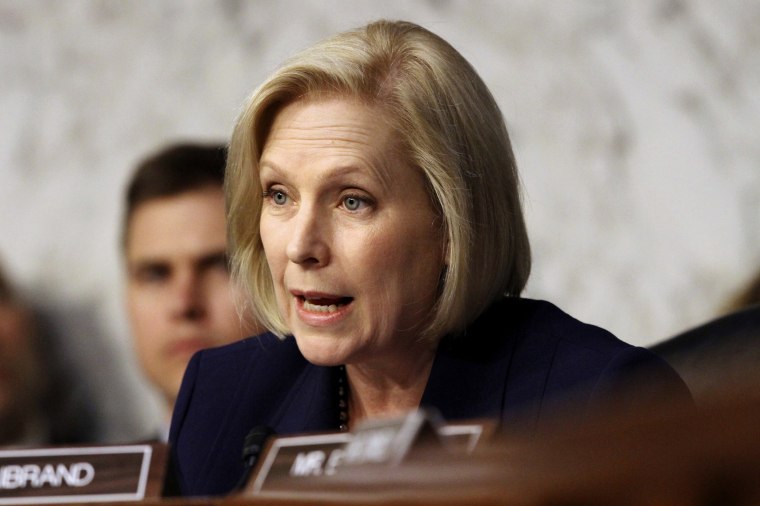A bipartisan gathering of legislators is meeting Wednesday on Capitol Hill for a hearing on paid family leave. The hearing, held in front of a subcommittee of the Senate Committee on Finance, is an attempt to shine a light on a crucial opportunity that research shows would strengthen both the economy and American families. But not all family leave plans are created equal.
As a country, we already know what kinds of paid family leave systems work well, because they exist or will soon start in six states and Washington D.C. Building on that precedent, there’s a bill currently before Congress that would make the same type of program national. The FAMILY Act, co-sponsored by Sen. Kirsten Gillibrand, was first introduced in 2013.
Unfortunately, Republicans have refused to back Gillibrand’s plan. Instead, Sen. Marco Rubio is backing a different, deeply flawed plan that critics say would undermine social security and ignore the caregiving needs of most Americans. (Having gotten a promise from Rubio during the 2016 election that he would educate himself on paid family leave, I’ve been especially disappointed.)
Ivanka Trump’s apparent refusal to work across the aisle is particularly frustrating given how outspoken she has been on so-called women’s issues.
Rubio has worked closed with Ivanka Trump, who publicly and repeatedly has supported the idea of paid family leave. But she also has refused to back the FAMILY Act. Sources tell Politico that she likes Rubio's plan and would "probably support it if it picked up support in Congress." This apparent reluctance to work across the aisle, however, is frustrating given how outspoken Trump has been on so-called women’s issues. If Trump really was committed to helping families, she would not be leaning towards a plan that will likely disadvantage large families and low-wage parents, as Elizabeth Breunig noted in the Washington Post recently.
To make all this clear, we have to start with what currently exists in the United States, and what “paid family leave” even means.
Under the Family and Medical Leave Act (FMLA), businesses that meet certain criteria are required to provide unpaid leave of up to 12 weeks for certain medical or caregiving needs, including caring for a new child. Unlike almost every other country on earth, the U.S. has no paid leave system even for mothers after giving birth.
The term “paid family leave” has been used by the U.S. government to refer to policies that provide funds for people to care for family members. That can include caring for a new child, but it can also include caring for an elderly parent, for example.
When many people hear the term, they assume it must be a requirement that businesses pay people for time off spent caregiving. That’s wrong.
In California, New Jersey, Rhode Island and now also New York, Washington state, Massachusetts, and Washington D.C., paid family leave is an insurance system. Small payroll deductions, either from workers or from both workers and businesses, go into a fund. When workers need paid family leave to care for a child, a sick spouse, an elderly parent, or to recover from an illness themselves, they receive a portion of their pay from the fund.
Businesses themselves are not required to pay salaries during leave. They can simply save the money or use it to pay temporary workers or overtime to existing employees.
The results of paid family leave at the state level aren’t just good, they’re fantastic.
In California, the overwhelming majority of businesses say it has had a positive, or at least neutral, effect on: “productivity (89 percent), profitability/performance (91 percent), turnover (96 percent), and employee morale (99 percent),” a study by researchers Eileen Appelbaum and Ruth Milkman found. And in New Jersey, when researcher Sharon Lerner visited 18 diverse businesses in 2014, she found that “six saw the law as neutral, while 12 felt it had a positive impact.”
Meanwhile, the vast majority of voters — including majorities of Democrats, Republicans and Independents — support paid family leave. And why wouldn’t they? The studies have found that it helps grow the economy, keep people in the workforce and reduces dependence on public assistance programs.

When I met with members of the previous Congress in 2015 to push them to support the FAMILY Act, the responses were consistent: Democrats said they support it and Republicans offered no arguments against it. But so far, no Republicans have been willing to sign onto it.
Instead, Trump, Rubio and other conservatives have acted as though lawmakers need to create a solution from scratch. And now, according to numerous reports, Rubio based his plan on a proposal from a group called the Independent Women’s Forum. (Kellyanne Conway, counselor to President Donald Trump, is listed as a member of its board of directors emeritae.)
Rubio's plan essentially would allow people to reach into their own Social Security funds to for leave. The problems with this approach are plentiful. As Slate notes, a study by the Urban Institute found that this plan “isn’t cost-neutral, as Republicans claim, and would cut or withhold Social Security benefits from future generations of parents — from a 3 percent reduction in retirement benefits for parents of one child to a 10 percent for parents of four children.”
"Any plan that robs the Social Security trust fund will hurt low-income workers, seniors and women the most," Gillibrand said in a statement. "Women already receive less Social Security benefits than men, and this plan only exacerbates that problem."
Rubio's plan essentially would allow people to reach into their own Social Security funds to for leave. The problems with this approach are plentiful.
Also, the plan only offers parental leave, rather than paid family leave. The vast majority of people who take unpaid leave under FMLA actually use it to recover from illness or care for an ill relative — a spouse, child, or parent. Only 21 percent take it to care for a new child, according to the Department of Labor.
"It is very encouraging that a growing number of lawmakers on both sides of the political aisle agree, at least in principle, that the United States needs a national approach to paid leave,” Vicki Shabo, vice president of National Partnership for Women and Families, told me for this column. (Like me, Shabo is part of a working group for paid family leave that advises Gillibrand’s office.)
“But details matter tremendously,” Shabo adds, “and a program that covers only new parents and excludes millions of others who need family or medical leave, undermines social insurance protections without new revenue, fails to replace wages at rates that allow both lower-income and middle-income families to afford leave, and fails to provide employment security beyond what the FMLA provides is not the approach we support or the country needs."
While many issues of our time are complex, paid family leave is an exception. As a nation, we already have all the information we need in order to know what works best and what American voters want. It’s time for the confusion and inaction to end. Paid family leave can happen through the FAMILY Act. It’s time to make it so.
Josh Levs is an award-winning journalist, business consultant and the author of "All In." The United Nations named him a Global Champion of Gender Equality.
